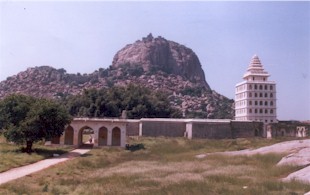
GINGEE FORT
Nestled on three hills, and enclosed by a huge rampart 60 feet thick, stands the majestic GINGEE Fort, in the Villuppuram district, which is located on the Thindivanam to Thiruvannamalai road about 25 kms from Thindivanam and 130 kms from Chidambaram. The indomitable courage and valour of its erstwhile rulers, caused Father pimenta, a Jesuit priest to call the GINGEE Fort the Troy of the East Besieged by the Mughals and battered by the British, the fort still stands at 800ft. in height, guarded by a moat, eighty feet wide. Much of the early history of this 800Year old fort is shrouded in mystery,as the fort seems to have changed many hands times before it was annexed to the Vijayanagar empire.
Gingee is known as GINGEE in Tamil. The small town of GINGEE was once a capital city, With its province extending from Nellore in the north to the Coleroon (Kollidam) in the south. According to local legend, GINGEE Amman, was one of the seven virgins who were the guardian deities of the Village. Legend has it that at around 1200 A. D. , GINGEE was fortified by Ananda Kone, chief of the local shepherd community. In 1240 A. D. Krishna Kone . His successor is said to have fortified the northern hill which later came to be known as krishnagiri.The kone dynasty gave way to the kurumbars, who established their headquarters at Sendamangalam,which later came under the powerful Chola empire. Recorded history goes back to the 16th century, when Gingee (GINGEE) became the seat of the Nayaka rulers, who were under the lordship of the expanding Vijayanagar empire. Krishnadevaraya appointed Krishnappa Nayaka, and he was considered the founder of the Nayaka line of Gingee.
Most of the structures, fortification walls and temples were built during this period. The fortifications and defenses were further strengthened under chatrapati shivaji, the great Maratha ruler, was captured Gingee in 1677 A. D. Gingee came under the hegemony of the Moghul emperor Aurangazeb in 1691 A. D., and sarup singh was appointed as the chief of Gingee by the emperor, under the control of the Nawab of Arcot.
Sarup Singhs son. Raja De singh, revolted against the Nawab of Arcot, and was defeated and killed in the war that followed. Though Gingee became a part of the Nawabs territory in 1714 A. D . the young and courageous De Singh became a legend and his heroic deeds were sung in the form of popular balads. Thus Gingee too became quite well known. In 1750 A. D., Gingee came under the french rule and remained so till it was surrendered to the British in 1761
GINGEE today, with its ruined forts, temples and granaries, presents a different picture from the glorious splendor of its bygone days. But the remains of that valorous past, speak volumes about the numerous invasions, warfare and bravery that it witnessed. We invite you to this land of the brave and mighty, to witness a glorious past that still lives in the ruins of the GINGEE fort.
The forts are located on either side of the road to T. V. Malai . They are open from 8.00 HRS. to 17.00 HRS. Any assistance can be sought at the ASI office or the ticket counter
2 comments:
We Welcome you to Packers And Movers Pune . We can assist you on your household shifting. Shifting home to a new place is considered as a hectic and tedious task.
Packers And Movers Wakad Pune
Packers And Movers Hinjewadi Pune
Packers And Movers Aundh Pune
Packers And Movers Pimple Saudagar Pune
Packers And Movers Viman Nagar Pune
Packers And Movers Kothrud Pune
Packers And Movers Kharadi Pune
Packers And Movers Hadapsar Pune
Century Bike Transportation Pune, Mumbai, bangalore, Hyderabad Delhi.
Post a Comment